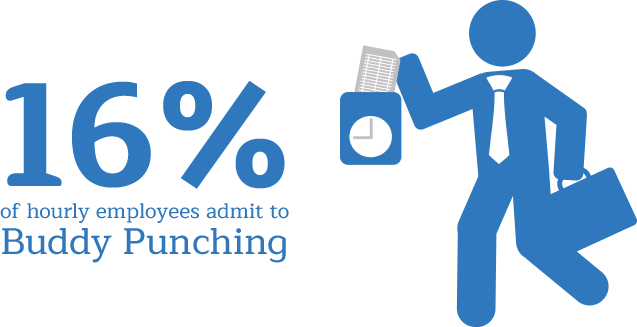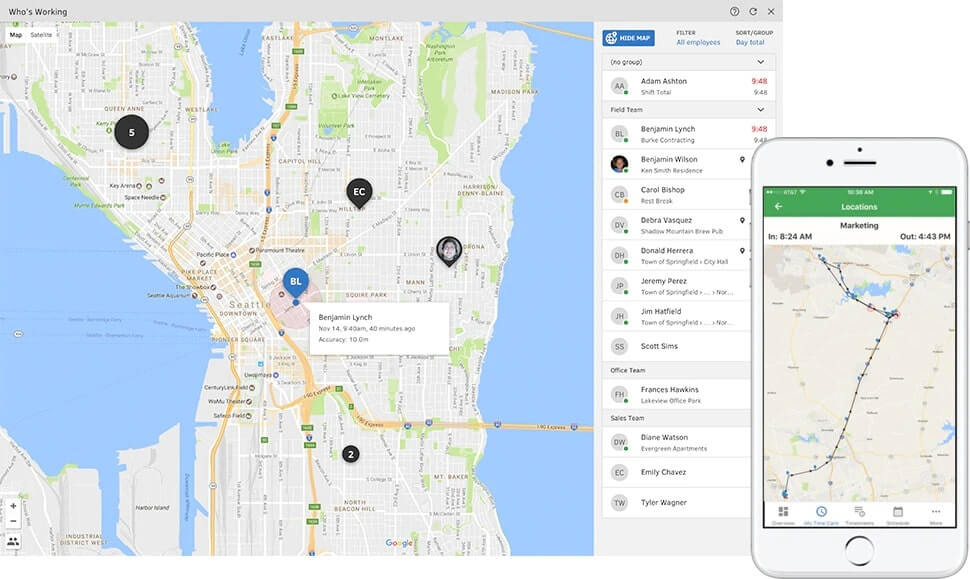New research published in 20171 suggests that a simple payroll loophole could cost U.S. employers more than $373 million every year. The loophole is well-known and widespread. It’s called buddy punching.
What is Buddy Punching and How to Prevent It
Why Buddy Punching Costs U.S. Employers $373 Million a Year and What You Can Do About It

What Is Buddy Punching?
Buddy punching occurs when one employee asks another employee to clock in on their behalf. In some cases, employee #1 is running late or has not arrived to work at the scheduled time, so they ask employee #2 to clock in for them, in the hopes that the manager or supervisor on duty won’t notice the late arrival.
This is usually accomplished by sharing personal clock in information, like usernames and passwords. And if a company is still using an “old-school” punch time clock or outdated paper timesheets, it’s even easier for employee #2 to simply stamp their “buddy’s” time card.

However, there are more extreme cases of employees using buddy punching to take entire days off work or accrue extra overtime. In short, some employees use it to trick their employer into paying them for large chunks of time not actually worked.
An independent survey of 1,000 employees in 2017 found that 16 percent admitted to clocking in for a colleague.2 The same survey found that timesheets are most commonly submitted weekly and that when errors are made, the most common mistake people make is to add an extra 15 minutes. The latest data published by the U.S. Bureau of Labor statistics indicates that there are more than 78 million hourly workers in the American workforce. If 16 percent of them added 15 minutes to a co-worker’s timesheet by buddy punching, this would add more than $373 million to the annual payroll bill.1
No matter how much or little time is being added to a time card dishonestly, buddy punching is time theft — and for small businesses with tight margins, it’s a big deal.
How Can I Prevent Buddy Punching?
One simple way to help prevent buddy punching is suggesting your employees to use a sensitive clock in password or longer pass-phrase (as opposed to the traditional password). As long as it’s something an employee won’t want to give away — even to their friends. For example: Some employers suggest their employees clock in and out using the last four digits of their Social Security number. It’s not a number employees (or anyone) want written down or handed out, so the likelihood of those numbers being passed around is low.
Of course, some businesses want even more control and safeguards to prevent buddy punching. Consequently, they invest in expensive and complicated biometric time tracking systems or geofencing. But those systems can be more of a headache than a solution, if not properly maintained.
What Is A Biometric Time Clock?
In the world of time tracking systems, biometrics refers to the ability to clock in or out using facial recognition, voice recognition, a fingerprint swipe, or a retina scan — usually in an effort to curb and control buddy punching. But this technology might not be as foolproof as you think.

Biometric time tracking systems tend to be extremely expensive — not to mention extremely glitchy, which results in the inability to clock in or out. The system assumes a worker’s face or finger won’t be dirty, and that their face, voice, eyes, or fingerprints will never change due to age, illness, lighting, or injury. As such, these systems require regular maintenance and frequent updates — increasing their already hefty price tag.
At the end of the day, biometric time clocks simply don’t solve the issue of buddy punching. If an employee is unable to clock in using the biometric system for any reason, most software will automatically prompt the employee to instead clock in using a PIN or password — rendering the biometric useless. Without that backup option, employees would be unable to clock in at all — even if they did everything right — simply because the biometric system malfunctioned.
What Is Geofencing?
A geofence is a virtual barrier that defines a geographical boundary. In terms of using geofencing for time tracking, it prevents employees from clocking in or out unless they’re within the geofence boundary. In some cases, the geofence will actually clock the employee in automatically, once they enter the geofence, and clock them out when they leave. It might sound like the perfect solution, but it can be a logistical, not to mention costly, nightmare.
See the pros and cons of geofencing — and discover cost-effective alternatives.

Much like biometrics, geofencing hardware and software costs a pretty penny — and it requires expensive maintenance and upkeep. On top of that, it can be costly to your employees as well. Apps that include geofencing technology take up a lot of space on a mobile device, and because those apps constantly pull the employee’s location, they suck up a lot of data and drain battery life (the No. 1 concern for employees who are tracked while on the clock).
And if your job site ever moves or your employees travel between multiple job sites, reconfiguring those boundaries can be a huge (and, once again, expensive) undertaking. Long story short, anytime your geofencing software experiences a glitch or needs an update, your employees won’t be able to clock in quickly or easily. They’ll have to contact an admin or find a supervisor to clock them in manually — a waste of valuable work time that leads to inaccurate paychecks.
What Is The Best Alternative To Geofencing?
Easy: GPS-enabled employee time tracking. For most businesses, it’s the right solution to solve for buddy punching, because it’s less expensive, less glitchy, and easier to maintain than biometrics and geofencing. Not only can you curb buddy punching by using a mobile, cloud-based time tracking system to track employee time, but when that system comes fully equipped with GPS tracking, you can rest assured that your employees are where they say they are when they clock in for work. Plus, network restrictions can prevent employees from clocking in or out from outside your secured network, and secure usernames and passwords can eliminate the temptation to buddy punch.
See what employees really think about GPS location tracking apps
